Welcome to all the DIY enthusiasts and mechanics out there! Are you tired of struggling to remove an engine from a car just by using brute strength and basic tools? Or perhaps you’re a beginner in the world of auto repairs, looking for a guide on how to use an essential tool like an engine hoist. Well, look no further because we’ve got you covered.
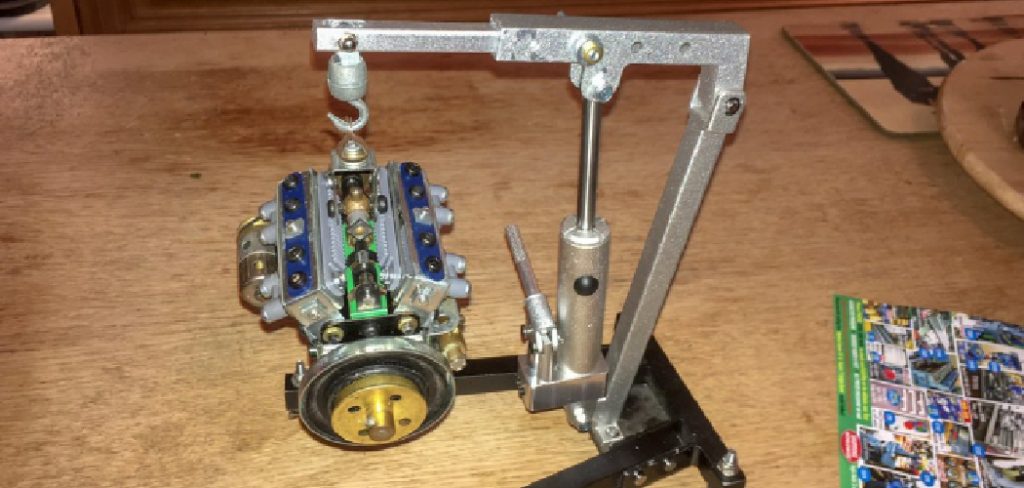
In this comprehensive guide, we’ll be taking you through everything you need to know about how to use an engine hoist effectively and safely. Whether it’s your first time attempting such a task or you simply want to brush up on your knowledge, buckle up as we delve into the exciting world of engine hoisting. So grab your coffee (or energy drink) and let’s get started!
Why May You Want to Use an Engine Hoist? 5 reasons
1 . To Remove and Replace an Engine
The most common reason for using an engine hoist is to remove and replace an engine from a vehicle. Whether you’re upgrading to a more powerful one or replacing a faulty engine, an engine hoist will come in handy to lift the heavy load with ease.
2 . To Rebuild an Engine
If you’re planning on rebuilding your engine, an engine hoist will be your best friend. It allows you to lift the engine out of the vehicle and onto a stand or workbench for easier access and maneuvering. This is especially useful when working on intricate parts and components.
3 . To Clean or Inspect the Engine
Regular maintenance of your vehicle’s engine is crucial for its longevity. By using an engine hoist, you can safely remove the engine from the car to thoroughly clean and inspect it without having to crawl under the car or risk damaging other parts.
4 . To Install Other Parts or Components
Sometimes, you may need to install other parts or components that require the engine to be removed. These can include a new transmission, exhaust system, or even a supercharger. An engine hoist makes it easier and safer to lift the heavy engine in and out as needed.
5 . To Move Heavy Objects
Apart from automotive use, an engine hoist can come in handy for other tasks that require lifting heavy objects. You can use it to move furniture or equipment around your shop or garage, making it a versatile tool to have on hand.
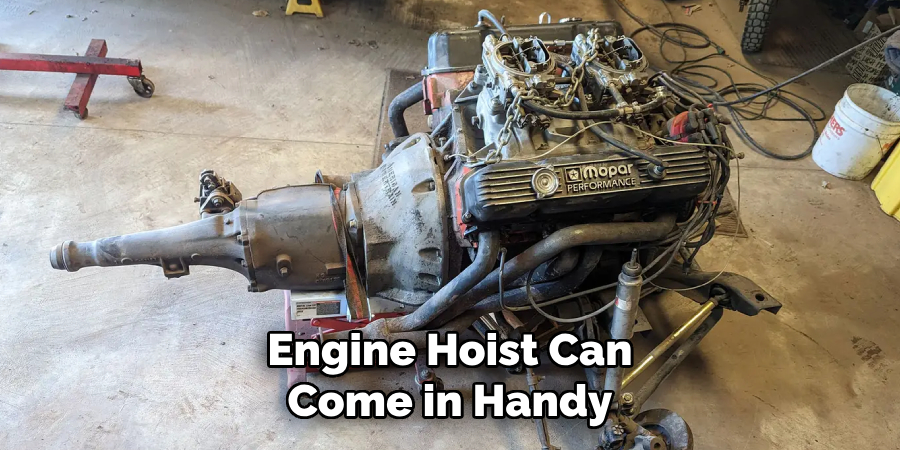
Step-by-Step Guide on How to Use an Engine Hoist
Step 1: Gather the Necessary Tools and Equipment
Before you begin, make sure you have all the necessary tools and equipment on hand. These include:
- Engine hoist (also known as a cherry picker)
- Heavy-duty chains or straps
- Safety goggles
- Gloves
- Safety stands or wheel chocks
Step 2: Prepare the Vehicle
Park your vehicle on a flat and level surface and engage the emergency brake. If you’re working on a manual transmission, place it in gear to prevent any movement. For an automatic transmission, make sure the parking brake is engaged.
Step 3: Position the Engine Hoist
Position the engine hoist near the vehicle with enough space for maneuvering. Make sure it’s on stable ground and all four wheels are locked in place. Also, ensure that the hoist arm is at its lowest position and the boom is extended outwards.
Step 4: Attach the Chains or Straps to the Engine
Attach one end of the chains or straps to the engine. Make sure they are securely fastened and can support the weight of the engine. You can use a cradle attachment for added stability. Also, be mindful of any delicate or sensitive parts that may get damaged by the chains or straps.
Step 5: Attach the Chains or Straps to the Engine Hoist
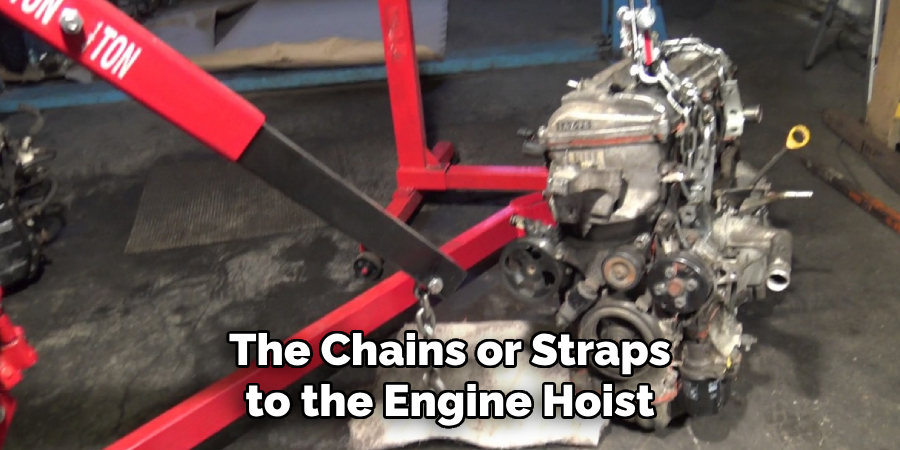
Attach the other end of the chains or straps to the engine hoist. Make sure they are evenly spaced and balanced to prevent any tilting. If using a cradle attachment, position it over the engine hoist’s hook and secure it in place.
Step 6: Begin Lifting the Engine
Slowly start pumping the hydraulic jack to lift the engine. Keep an eye on all connections and make sure there are no signs of slipping or tilting. If necessary, adjust the chains or straps to maintain balance. Once the engine is lifted high enough, stop pumping and lock the jack in place.
Step 7: Move the Engine to Its Desired Location
With the engine hoisted, you can now easily move it to its desired location. This could be a workbench, an engine stand, or simply out of the way for cleaning or inspection. Always make sure to keep your hands and feet away from under the lifted engine and maintain a safe distance from the hoist.
Step 8: Lower the Engine
Once you’re done with your task, it’s time to lower the engine back into place. Make sure to do this slowly and carefully, keeping an eye on all connections. Once the engine is securely back onto its mounts, remove the chains or straps and disassemble the engine hoist for storage.
Safety Tips When Using an Engine Hoist
1 . Wear Safety Gear
Always wear safety goggles and gloves when using an engine hoist to protect yourself from any potential hazards. Also, make sure your clothing is not too loose or baggy, and avoid wearing any jewelry.
2 . Inspect the Hoist Before Use
Before using an engine hoist, always inspect it for any signs of wear or damage. Pay attention to the hydraulic jack and connections, as well as the chains or straps. If you notice anything out of the ordinary, do not use the hoist and have it inspected or repaired by a professional.
3 . Securely Attach the Engine
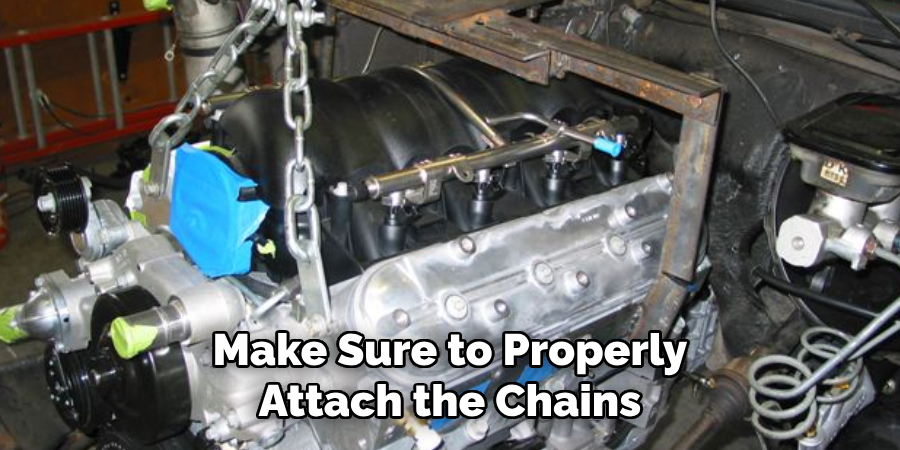
Make sure to properly attach the chains or straps to both the engine and the hoist. This will prevent any tilting or slipping while lifting, which can be dangerous for you and your vehicle.
4 . Use Wheel Chocks or Safety Stands
To prevent any accidental movement of the vehicle, use wheel chocks or safety stands. This will keep the car in place and add an extra layer of safety while working under it. Also, make sure to always engage the emergency brake.
5 . Never Exceed the Hoist’s Weight Capacity
Each engine hoist has a weight capacity that must not be exceeded. Make sure to check this before use and avoid lifting anything heavier than what the hoist can handle. Overloading the hoist can result in failure and potential injury.
6 . Never Work Under a Lifted Engine
Always maintain a safe distance from the lifted engine and never work underneath it. In case of any accidents or malfunctions, you could be seriously injured. Always keep yourself and others away from the hoist while in use.
Frequently Asked Questions
What Precautions Should I Take When Using an Engine Hoist?
Always wear safety gear, inspect the hoist before use, securely attach the engine, use wheel chocks or safety stands, avoid exceeding weight capacity, and never work under a lifted engine.
Can I Use an Engine Hoist for Other Tasks Besides Automotive Work?
Yes, you can use an engine hoist to move heavy objects such as furniture or equipment in your shop or garage.
How Do I Properly Store an Engine Hoist?
Make sure to clean and lubricate the hoist before storing it. Disassemble it if possible and store it in a dry, clean place away from any potential hazards. Also, make sure to follow any specific storage instructions provided by the manufacturer. Remember to inspect and test the hoist before using it again after storage.
Can I Use an Engine Hoist Alone?
While it is possible to use an engine hoist alone, it’s always recommended to have a second person present for added safety and assistance. This is especially important when moving the engine to its desired location or lowering it back into place.
Is It Necessary to Use a Cradle Attachment with an Engine Hoist?
It’s not necessary to use a cradle attachment, but it can provide added stability and prevent any damage to delicate or sensitive parts of the engine. It’s always recommended to use one if available. Also, make sure to properly position and secure the cradle attachment before lifting.
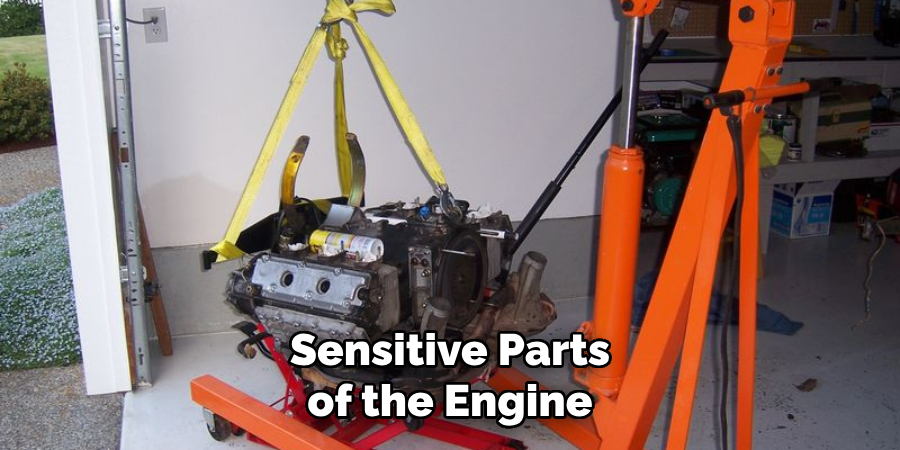
Finally, always follow any specific instructions provided by the manufacturer for using a cradle attachment with your particular engine hoist model. If in doubt, seek professional guidance or assistance.
Conclusion
Now you know how to use an engine hoist safely and effectively. Remember to always follow these steps and safety tips for the successful use of the hoist. Whether it’s for automotive purposes or other heavy lifting tasks, an engine hoist is a valuable tool to have in your arsenal. So, be sure to keep yours properly maintained and always prioritize safety when using it. Happy lifting!

About
JeepFixes Team is a skilled author for Jeep Fixes, bringing 6 years of expertise in crafting a wide range of jeep fixes. With a strong background in jeep fixes work, JeepFixes Team’s knowledge spans various types of fixtures, from decorative pieces to functional hardware, blending precision with creativity. His passion for jeep fixes and design has made him a trusted resource in the industry.
Professional Focus:
Expert in Jeep Fixes : JeepFixes Team aesthetic specializes in creating durable and innovative jeep fixes, offering both appeal and functionality. His work reflects a deep understanding of jeep fixes techniques and materials.
Sustainability Advocate : He is dedicated to using sustainable practices, ensuring that every fixture is crafted with eco-friendly methods while maintaining high-quality standards.
In his writing for jeep fixes, JeepFixes Team provides valuable insights into the latest trends, techniques, and practical advice for those passionate about jeep fixes, whether they are professionals or DIY enthusiasts. His focus on combining artistry with engineering helps others discover the true potential of jeep in design.
